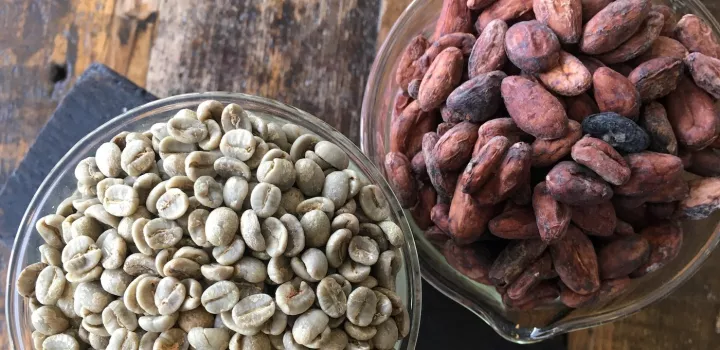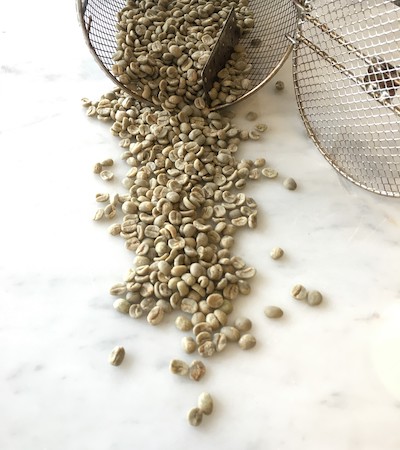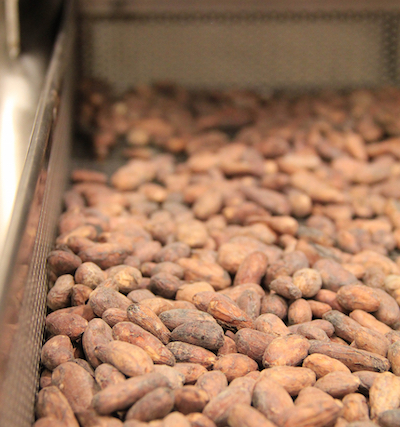
Cacao vs Coffee
Pastry chef and chocolate expert Michael Laiskonis compares and contrasts the beans.
Two interests merge in the ICE Chocolate Lab as we explore the similarities and the differences in approaches to roasting coffee and cacao beans.
Long before I developed a passion for working with chocolate, I began fostering a love for coffee. I don’t exactly recall the occasion of my first pre-teen taste of coffee, but it subconsciously served as a rite of passage into a mysterious grown-up world. I’m also betting on the likelihood that it wasn’t a very good cup of coffee — most likely pummeled to muddy mediocrity in some pitiless percolator and then served forth in a flimsy Styrofoam cup. In hindsight, the event marked instant access to sophisticated taste, a sense of ritual and increased social capital.

Coffee symbolized the exotic and the mundane, the hip and the old-fashioned; chocolate, in a way, represents those same dichotomies. Since then, I’ve always tiptoed along the edge of serious coffee culture. I did play around with some early but uninformed experiments in roasting green coffee, long before coffee’s artisan third wave began 20 years ago and the dissemination of roasting knowledge down to the home enthusiast. One might say that we are at a similar place with chocolate today, with makers and consumers raising the bar of quality and appreciation. In recent months I’ve leaned further into roasting coffee, fascinated by the differences and similarities I found as a chocolate-maker.
When I started to learn about wine as a young cook, I got some great advice from a sommelier I worked with. He suggested I stick to a couple of Old-World regions first to learn the lingo and how to taste and then branch out into other origins and styles of wine from there. To this day, those two regions (the Rhône Valley for red, the Loire for white) remain sentimental favorites. Probably because I had some degree of fluency in cacao when I started making chocolate, I went the opposite way, wanting to play with all the beans from everywhere all at once, embracing all their variabilities. Now that I’m roasting coffee, I’m going back to the focused approach. At the moment, I’m limiting myself largely to Central America and drilling deeper into a few regions in search of interesting beans, identifying the nuances of terroir, cultivar and processing, all while learning to achieve consistent, predictable roasts.
Interestingly, the consumption of coffee and cacao emerged beyond their origin into Europe around the same time, gaining a popular foothold in the 17th century. Prior to that, coffee thrived in East Africa and the Arabian Peninsula, while cacao-based beverages were limited to the cultures of Central and South America before the arrival of Spanish conquistadors. The convivial culture of the coffee and chocolate houses evolved, and clear camps of preference emerged; chocolate, interestingly, was favored by some as a more nourishing and healthier beverage with a milder stimulating effect than coffee. Though coffee (and for some, tea) would become a ritualized part of our daily routine, chocolate went on to lay claim to a much wider range of applications beyond the cup and into desserts and confections.
Coffee and cacao grow within the same tropical belt and share common origins and producer countries from Africa to Central and South America, Oceania and Southeast Asia. Cacao prefers low-lying forest conditions, while coffee quality is generally linked to higher altitudes, the most complex flavor profiles attributed to elevations beginning around 1,000 meters above sea level. Both can be broadly separated into cheap commodity beans and fine flavor grades; quality in cacao and coffee is highly dependent on origin, varietal and post-harvest processing as well as roasting, and for chocolate, subsequent manufacturing steps. Both are the seed of a fruit — the coffee "cherry" and the cacao pod that contains 30-40 seeds or beans. While much of chocolate’s flavor is developed during a lengthy fermentation process, for coffee, a short fermentation has less impact on flavor and is more a means of separating the seed from the fruit. From a composition perspective, cacao beans contain much more fat (50% versus 14%) while coffee beans have a greater percentage of carbohydrates or sugars (50% versus 20%). Dried cacao beans have a moisture content from 6% to 8%, while green coffee beans contain 8% to 12% moisture. Under proper storage conditions, both cacao and green coffee are stable for months before processing.

The mechanics of roasting coffee and cacao, on the surface, are quite similar. Both benefit from the even heat of a rotating drum roaster, where the beans are in constant motion, but the similarities end there. The intensity, duration and chemical processes differ. Coffee likes a hot-and-fast approach while cacao requires less heat and more time. This is, in part, due to the size of the beans. On average, the weight of cacao is 10 times that of a coffee bean. Flavor development for both begins at the point when moisture loss occurs. The higher bean temperature required for coffee (in excess of 200 C/400 F) results in caramelization of sugars, and for darker roasts, pyrolysis – thermal decomposition that might also be described as controlled burning. As they roast, coffee beans expand, turning from green to brown, and audibly crack ("first" and "second" crack mark notable points in roast development). With the momentum of the high heat, coffee bean flavors develop rapidly, and the profile can shift drastically in a matter of seconds.
By contrast, cacao beans are treated in a comparatively low-and-slow manner. Flavor development during roasting is largely based on chemical precursors formed during post-harvest fermentation. Proteins, or amino acids, and "reducing" sugars react with heat to produce Maillard reactions and Strecker degradation. Though Maillard reactions typically result in the browning of foods, the brown color of chocolate is due in large part to the fermentation process, though roasting can contribute. In contrast to the high temperatures associated with coffee, the final bean temperature might range from 120 C/250 F for light roasts to 135 C/275 F for the deepest roasts. In cacao, there is also a subtractive element to roasting; volatile and vinegary acetic acid resulting from fermentation is driven off. High-quality beans of both cacao and coffee generally tend to reveal subtle nuances and complexity when roasted on the lighter side. With experience and control of the many variables, roasters can pinpoint the ideal parameters for beans of specific origins, genetics and processing.
At the end of roasting, coffee and cacao both require rapid cooling, or quenching, to halt the process. Both lose a significant amount of weight during the roast due primarily to moisture loss — I expect to lose 5% in cacao and up to 14% in coffee. In addition to moisture loss, coffee also releases "chaff" — its paper-thin husk — during the roast. Cacao’s more substantial shell requires additional processing (winnowing) to remove. The transformation into finished chocolate requires several steps after roasting; and while coffee brewing is an art and science itself, roasting, with all its subtlety, is the primary processing step. Freshness is considered key to optimal coffee flavor, but just-roasted beans are typically aged for a day or two (or up to a week) before grinding and brewing to allow for the de-gassing of carbon dioxide created during the roasting process. Finished chocolate is often aged, too, as flavors do shift over time, though there is little published research to explain how those flavors change.
I’ve come to appreciate both approaches necessary when working with coffee and chocolate — and I find that better understanding one helps inform how I view the other. I like to say that the more I learn about cacao and chocolate, the more I realize I don’t know, and as I continue down the path of coffee that statement rings doubly true, as slight variations of the green beans or a few seconds in the roaster might translate into a very different cup.
Pursue a career in chocolate with ICE's Pastry & Baking Arts program.


Coffee and Chocolate
Submitted by Annamarue canadeo on May 9, 2021 5:25am
We never realize the sultilties of making good coffee and good chocolate.. fascinating,,, thanks
Chocolate & Coffee
Submitted by Daniel Cosgriffe on May 11, 2021 7:14pm
As a former pastry chef, wish I could afford much higher quality chocolate, however, I work with 70% callebaut, almost a couverture chocolate. As a rule when making hot chocolate for my Love, I will caramelize the organic sugar, use a vanilla bean or two, a few tbs of butter, always adding some Himalayan salt, a cinnamon stick or two and then sometimes adding some or all of powdered ginger, cloves or nutmeg in varying amounts. I also use goat milk and never go beyond heating this all up but for a few bubbles, never boiling and burning the chocolate. All this all makes a decent hot chocolate.
And then I’m able to acquire amazing coffees from a great shop here in Toronto called The Coffee Bouquets. This place has coffees from the Himalayan Mountains and the Galápagos Islands and everywhere in-between. Some of my favourites are Kaffa from Ethiopia and beans from the Flores Island in Indonesia, but one that makes amazing mocha and is great with a little 10% cream are coffee beans from Cuba. I’m not always able to get Cuban beans, but when I can I’m generally in heaven. Heck my partner likes her mocha 2/3rds hot chocolate and 1/3rd coffee and can still taste the amazing coffee!
Add new comment